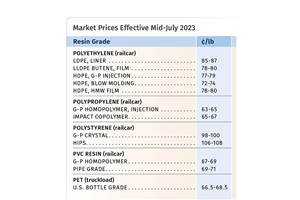Wood On Plastics: Electronics: the Place to Be in 2010
After a few years of garnering only moderate profits, the U.S. electronics industry caught fire in 2010.
After a few years of garnering only moderate profits, the U.S. electronics industry caught fire in 2010. According to data recently released by the Bureau of Economic Analysis (BEA) in the U.S. Dept. of Commerce, the computer and electronics industry is on pace to see sales grow 10% but profits soar 250% in 2010 compared with total earnings in 2009. Through the first half of this year, this industry has amassed more profits than any other major manufacturing sector, even the perennially profitable food products and petroleum products.
This is good news for suppliers of electronics parts and components, including plastics processors. Profits drive corporate spending and bank lending for plants, equipment, and hiring employees. They also drive R&D activity, which in turn generates new products and increasing market demand, which then creates more profits. All of this is a self-sustaining “virtuous circle” made possible by a steady uptrend in profits.
Everybody knows that electronics have become ubiquitous, finding their way into autos, appliances, medical devices, and scores of other products. This trend will persist for the foreseeable future.
Unfortunately, it is difficult to capture steady and reliable data on the level of penetration of electronic components into these larger products. But data that the BEA compiles in two major areas show big gains thus far in 2010. These two areas are consumer spending for video, audio, photographic, and computer equipment and media; and ´óĎó´«Ă˝ investment in computers and peripheral equipment.
In 2009, U.S. ´óĎó´«Ă˝es purchased $80 billion worth of computers and peripheral equipment. Through the first two quarters of 2010, nonresidential investment in computers is running at a pace of more than $95 billion for the year, or an increase of about 20%. It has not gone unnoticed by many analysts that this propensity by ´óĎó´«Ă˝es to invest large sums of money in computers and other types of equipment this year is a sharp contrast to their willingness to hire employees. This divergence will not be sustained over the long run, but it is one of the characteristics of the current recovery cycle that will be analyzed and debated for years to come.
And while overall consumer spending has been sluggish this year, Americans’ enthusiasm for electronic products appears to be impervious to the lackluster rate of overall economic and employment growth. In 2009, U.S. consumers spent just over $270 billion on video, audio, photographic, and information-processing equipment and media. That is about the same amount that Americans spent on gasoline last year.
Through the first half of this year, spending on these products is expected to come in at $285 billion, or a 5% increase from last year. That may not seem such a robust rise when compared with the 20% jump in ´óĎó´«Ă˝ spending, but it is quite strong when overall consumer spending is expected to rise only about 1% to 2% this year. Consumers are spending significantly more of their household budgets on electronics this year than last, even though growth in household incomes is stagnant.
WHAT IT MEANS TO YOU
- If you supply plastics products to electronics OEMs, remember that precision and speed to market are keys to your success.
- Demands for precision and speed place a huge premium on the design phase of a product, and on the design of the manufacturing process that will produce them.
- America and Europe will remain the pre-eminent design centers for most types of electronics products, but the emerging economies in Asia will manufacture and consume an increasing share of them. Look into penetrating those markets.
Related Content
PS Prices Plunge, Others Appear to Be Bottoming Out
PS prices to see significant drop, with some potential for a modest downward path for others.
Read MorePOGS Chooses Novodur ECO ABS for Childrens Headphones
Manufacturer of audio equipment for children will use INEOS Styrolution ABS with 50% recycled content.
Read MoreVerde Bioresins Enters Planned Business Combination with TLGY Acquisition Corp.
Verde to become publicly traded via this ´óĎó´«Ă˝ ‘merger’.
Read MoreHow to Optimize Injection Molding of PHA and PHA/PLA Blends
Here are processing guidelines aimed at both getting the PHA resin into the process without degrading it, and reducing residence time at melt temperatures.
Read MoreRead Next
Lead the Conversation, Change the Conversation
Coverage of single-use plastics can be both misleading and demoralizing. Here are 10 tips for changing the perception of the plastics industry at your company and in your community.
Read MorePeople 4.0 – How to Get Buy-In from Your Staff for Industry 4.0 Systems
Implementing a production monitoring system as the foundation of a ‘smart factory’ is about integrating people with new technology as much as it is about integrating machines and computers. Here are tips from a company that has gone through the process.
Read MoreSee Recyclers Close the Loop on Trade Show Production Scrap at NPE2024
A collaboration between show organizer PLASTICS, recycler CPR and size reduction experts WEIMA and Conair recovered and recycled all production scrap at NPE2024.
Read More











